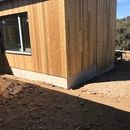Exterior Fiber Cement Board Below Grade
I installed a HardieBacker 5oo skirt around the building from the sole plate to just below grade. The fiber cement board is installed to protect the 2.5 inches of Rockwool we applied to the stemwall (and framed wall). The rainscreen siding terminates at the plate with a galvi drip edge covering the top of the Hardie board.
I am losing my confidence in the durability of the assembly for two reasons. First, someone questioned the content of the HardieBacker 500 and I found it has cellulose fibers. Second, Hardie does not approve it for contact with earth.
However, given the fact that it is a well drained building in fractured rock ‘soil’ and that the same product can withstand the conditions inside a shower, I am considering taking liability and leaving the installation. I plan to apply a finish coat of Thoroseal T1018 waterproofing. The house is at 400′ in the Sierra Foothills- a dry climate.
All of the builders I have talked to are in agreement that it will be a durable installation, but none of us have tried it.
I would love to hear some success stories with a similar situation instead of bad experiences but both are welcome!
Thank you.
(PS. This is Dave Good posting on a shared account under my wife’s name)
GBA Detail Library
A collection of one thousand construction details organized by climate and house part










Replies
Dave,
Three summers ago I faced a similar problem. My 3" reclaimed XPS foundation insulation is encapsulated with Grace Bituthene which needed protection from rodents and sun after waiting on me for a year. Originally, the plan was to skirt the house with corrugated metal that rusts over time like many homes in the area do. Mining shack chic, so to speak. I was concerned that the corrugation pattern would encourage critters and insects alike to nest, so I finally convinced myself to chance using 1/2" Hardibacker.
I recall that the material I got claimed it was suitable for steam showers, although I can't find any reference to support that now. I only have scraps left with no markings, so maybe I am confusing products. In any case, I managed to work out the details for hanging the board from a secondary drip flashing I have and also to tie the sheet edges together tightly. The result looks very much like a normal foundation color and the material won't cause staining like the rusting metal would have.
Due to wild fire regulations I had a convenient way to get around the ground contact or constant immersion limitation. At the time it was required to keep all vegetation a minimum of 5' off the house with washed stone being a practical method here in a semi-arid climate. I cut the soil profile to start 3" lower than needed first, then laid fabric down, hung the Hardiboard down to an inch and half above the fabric and then placed the washed stone up to the original height.
This put about 1 1/2" of stone cover onto the board so mice would be less motivated to attempt getting behind the board, which sits about a 1/2 "off the Bituthene. The tight edges and flashing drip edge confounds the insects as well. Since the bottom edge of the Hardi sits in a bed of open clean stone, any water we get drains quickly, even in much of the winter thanks to the sun warming effects. If, at minimum, you create a small trench you can fill with washed stone to cup the bottom edge of the Hardi, I think you will find it quite stable.
My north wall has a long spring period when all the snow off the roof sits in a pile that falls back against the board thanks to a slightly too short overhang. Despite the extra long soaking it gets, the north parts look as good as the others after two full winters. The attached picture is from before final grading on the northwest where the most fill adjusting was needed. I would go out and take an after photo if we didn't have 8" of snow on the ground. We extended the fire break stone out to 20'+ in all directions this year. We have had some scarily close fires in recent years.
Dave, I have seen it done several times and have not seen failures. But I would not risk it myself; I would use a system approved for ground contact.
Hardie backer is similar construction as their siding. Any water contact with freezing it turns to mush. I would go with something that can hold up to a bit of freeze/thaw cycling.
The simplest is solid metal flashing as the skirt but you can also look at some of the synthetic stucco products and for parging for ICF foundations. You can install the mesh over the rigid mineral wool and parge.
https://www.greenbuildingadvisor.com/question/stucco-over-exterior-mineral-wool-stotherm-ci-mineral
Finex makes a fibercement panel that is rated for below grade, freeze/thaw resistant, etc. http://gofinex.com/panneau_fibrociment_finex.php. I am not sure if it is available in the US at the moment.
Here is the Canada general inf:
USE: Protection / finish for foundation insulation
Faster and more durable than roughcast or stucco;
Use 1/4 "panels, 4 'lengths;
Drive the panels a minimum of 12 "into the ground;
Screw the panels to 24 ";
Flashing recommended.
I thought you weren't supposed to use acrylic stucco below grade because it traps the moisture and doesn't allow the foundation to dry (?) I am having to replace a bunch of crumbled cement and rotten wood window frames that were covered in acrylic stucco for about 12 years. The stucco extended about 5 inches below soil.